afootwego-01-travelling-back-in-time-on-a-steam-train-to-ballarat
afootwego Posts + Stories template
…for people who love to walk…
Supporting Mindful and Responsible Travel
This Post recounts the experience of a day-trip on a heritage Steam Train from Melbourne to Ballarat

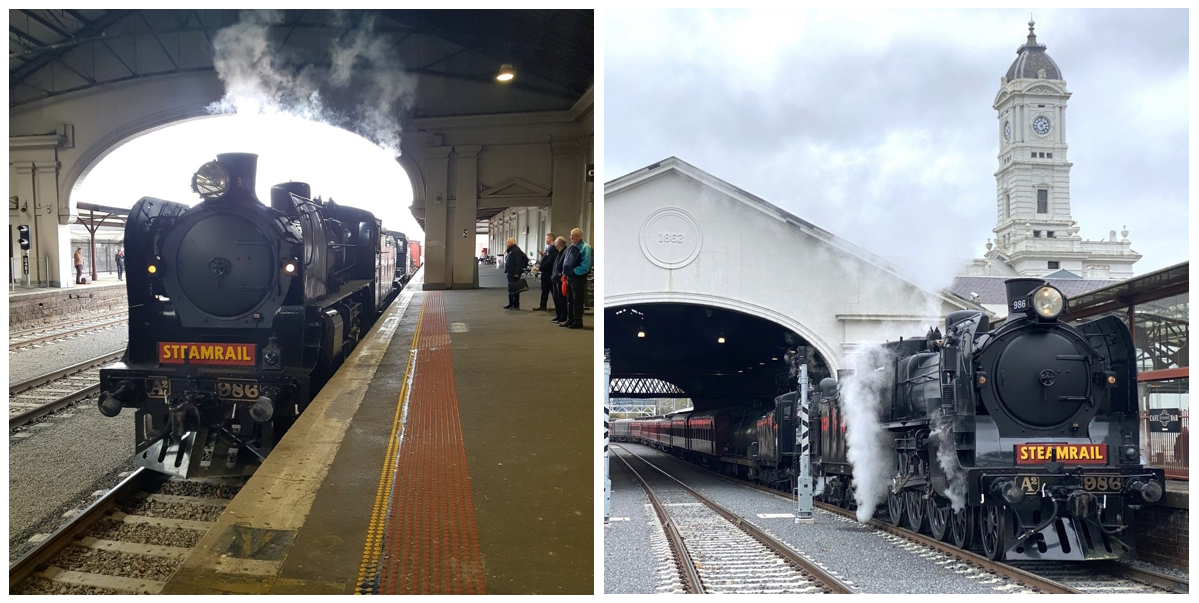
Travelling Back in Time on a Heritage Steam Train to Ballarat
May 2024
10
Friday 24 May, 2024
A Quick Outline
In this Post, we shall explore:
Let the Adventure Begin…
On a chilly Ballarat Friday morning, the Golden Plains Adventure started early, catching a V/Line train to Melbourne at around 07:00 am. A bit over an hour later, we alighted at Footscray Junction, made our way to Platform 6, and waited a few minutes for the next Metro train going via Newport.
Once at Newport, we would be embarking on the Steamrail Victoria ‘Newport-Ballarat Transfer’. As we boarded a Williamstown Metro train, a group of several other travelers joined us. All carrying backpacks, and chatting about what they were going to do in Ballarat, it was rather obvious what they were up to.
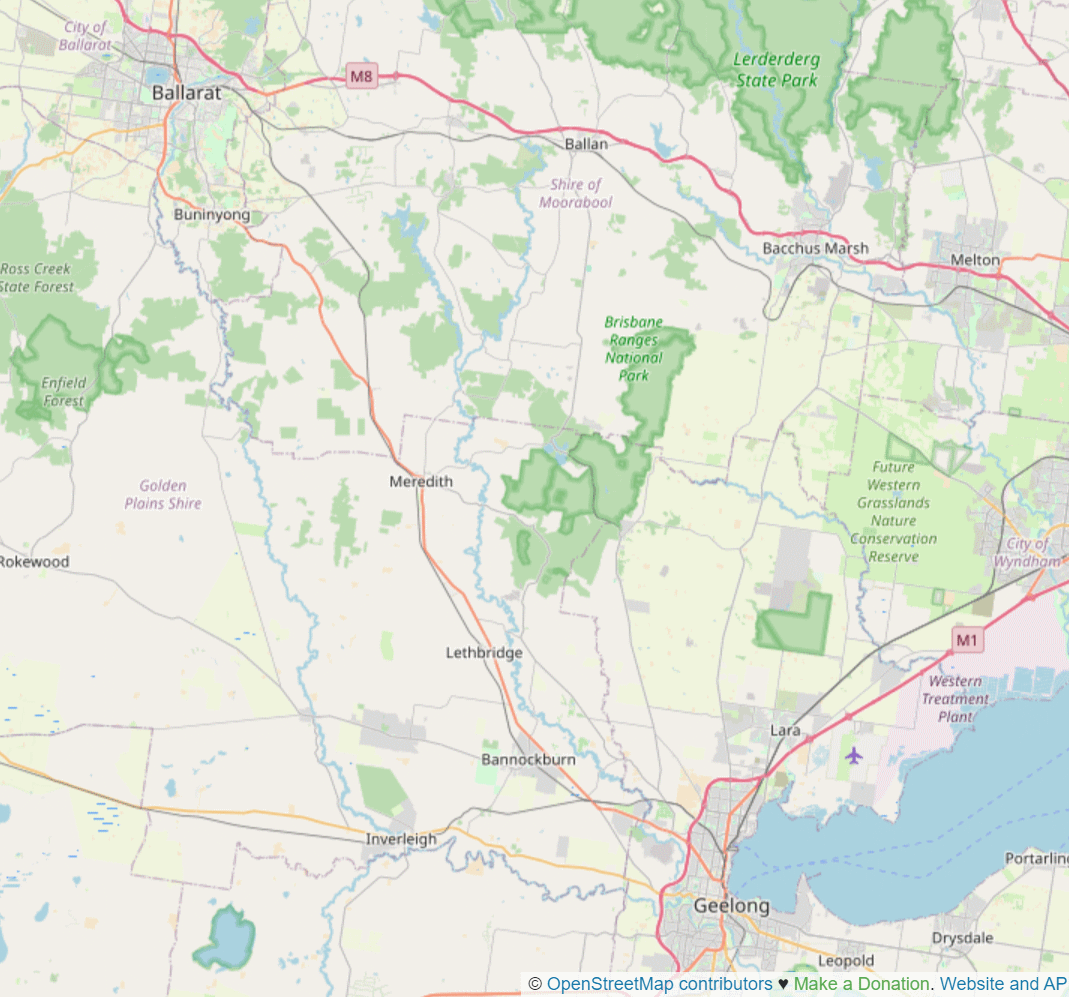
[The Railway tracks are shown by the darker grey lines, running close to the red-coloured highways]
Credit: OpenStreetMap
Sure enough, four stops later, at the Newport Train Station, we all alighted at Platform 2, and like a hungry mob of sheep, all headed through the subway and up into Hall Street. Soon, we were all crushing into Pango Coffee, on the corner of Tait Street, for a breakfast top-up.
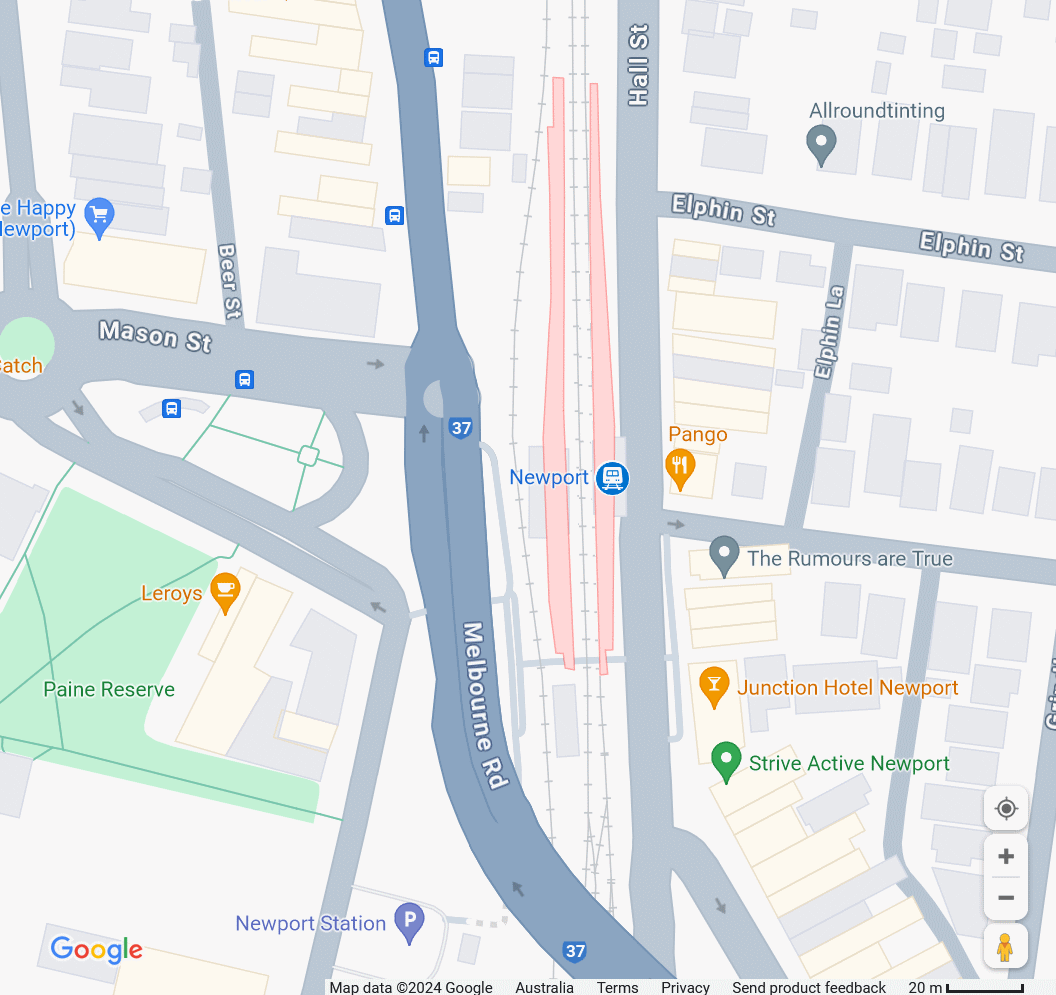
Credit: Google Maps
Pango was rather busy, and is obviously a local favourite. Somehow, a few extra Steamrail travellers squeezed in, somewhere. Judging by the meals that were soon being served, some of us were also very hungry!

At around 09:30 am, we paid our bill, and went for a wander around Newport, leaving a few of the other ‘Steamrailers’ in Pango’s warm and friendly atmosphere. Outside, the day was still, cool, and cloudy, but no sign of rain. Apart from some interesting street art of birds, there doesn’t seem to be a lot to see on the Hall Street side of Newport.
The historic Newport Railway Workshops and Steamrail Victoria are on the other (western) side of the rail tracks, about a 25-30 minute walk away (±1.8 km). We will keep that for another day (the Newport Railway Museum is open every Saturday, 12:00-5:00 pm).
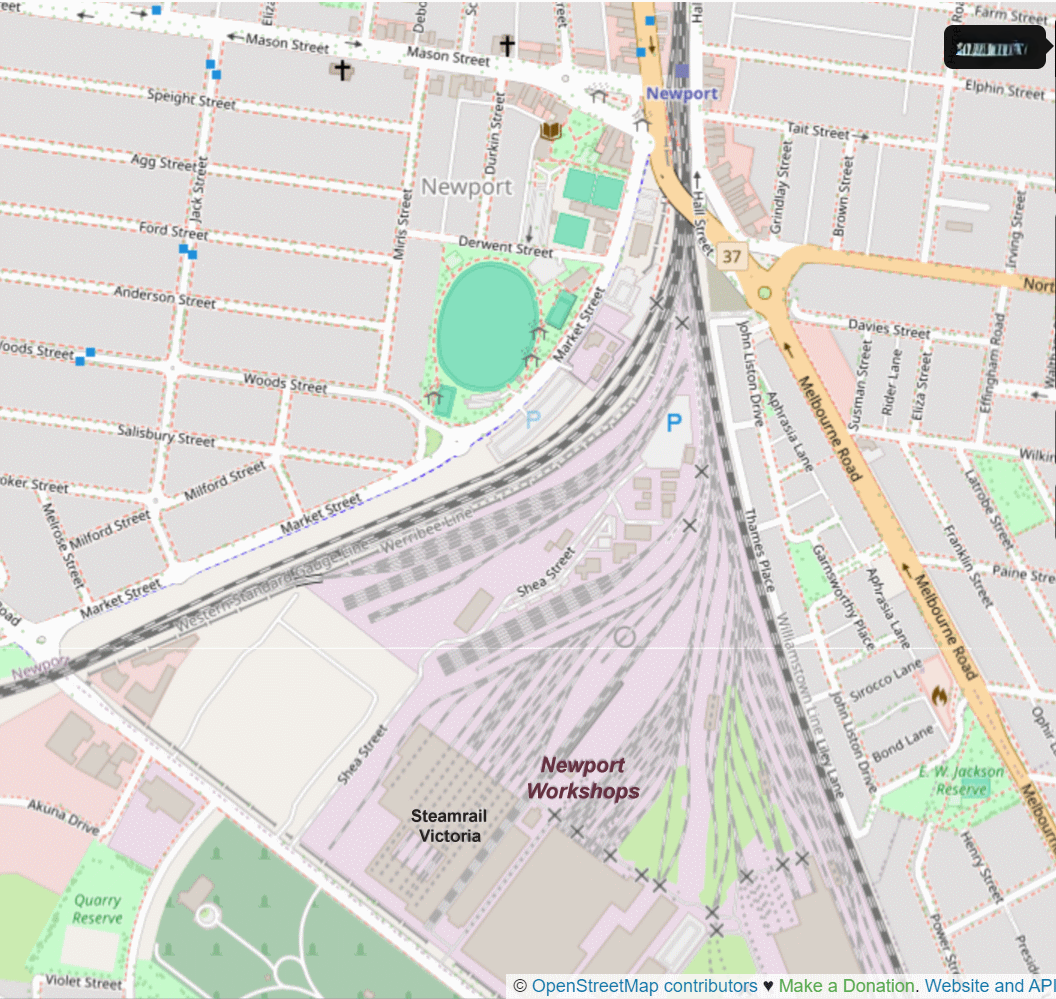
Credit: OpenStreetMap
Time to Get Onboard…
As we headed back into the Train Station subway, at around 10:25 am, ahead there was a stream of people walking up to Platform 1 (the ‘Up’ platform), where Metro trains towards Melbourne all stop. Like sheep, we followed, and joined the growing ‘gaggle’ of passengers on the platform.
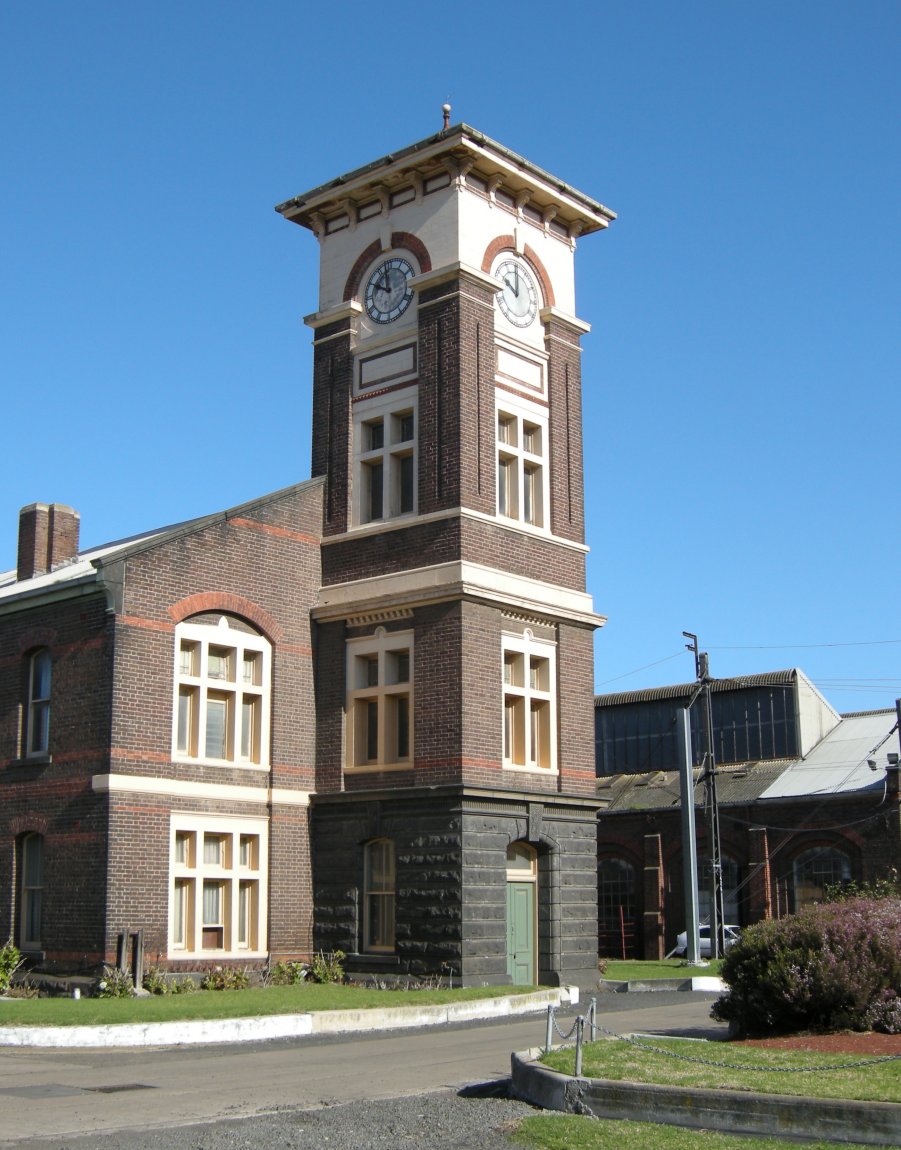
Newport Workshops Clocktower – Date Taken 22 August 2009
Some of the waiting throng soon departed on the next Metro train, and the next one after that. Meanwhile, the Station staff kept reminding all of us who remained about keeping behind the “yellow line”. As we waited, every now and then a bit of sun shone through the clouds, so standing on the open platform was not unpleasant.
As 10:30 approached, the crowd of ‘Steamrailers’ on Platform 1 continued to grow. The Station PA advised the arrival of a Metro train on Platform 1, followed quickly after by another. By now, my mobile said the time was 10:33 am. So, “what’s going on, guys!” I wondered out aloud.
Then, looking down the rail line, towards the Workshops, I caught a glimpse of a rising plume of steam and smoke, away in the distance. Closer, I could also see a single bright light. This was reassuring, but then another PA message, for yet another Metro train on Platform 1!

As the Metro train to Carrum Downs departed, we could all see the source of the single bright light. It was a dark blue and gold painted diesel engine, bearing a classic Victorian Railways livery, getting closer by the second. Also getting closer, was the source of the plume of steam, Soon, we could hear the unmistakable sound of a steam engine, drawing nearer.
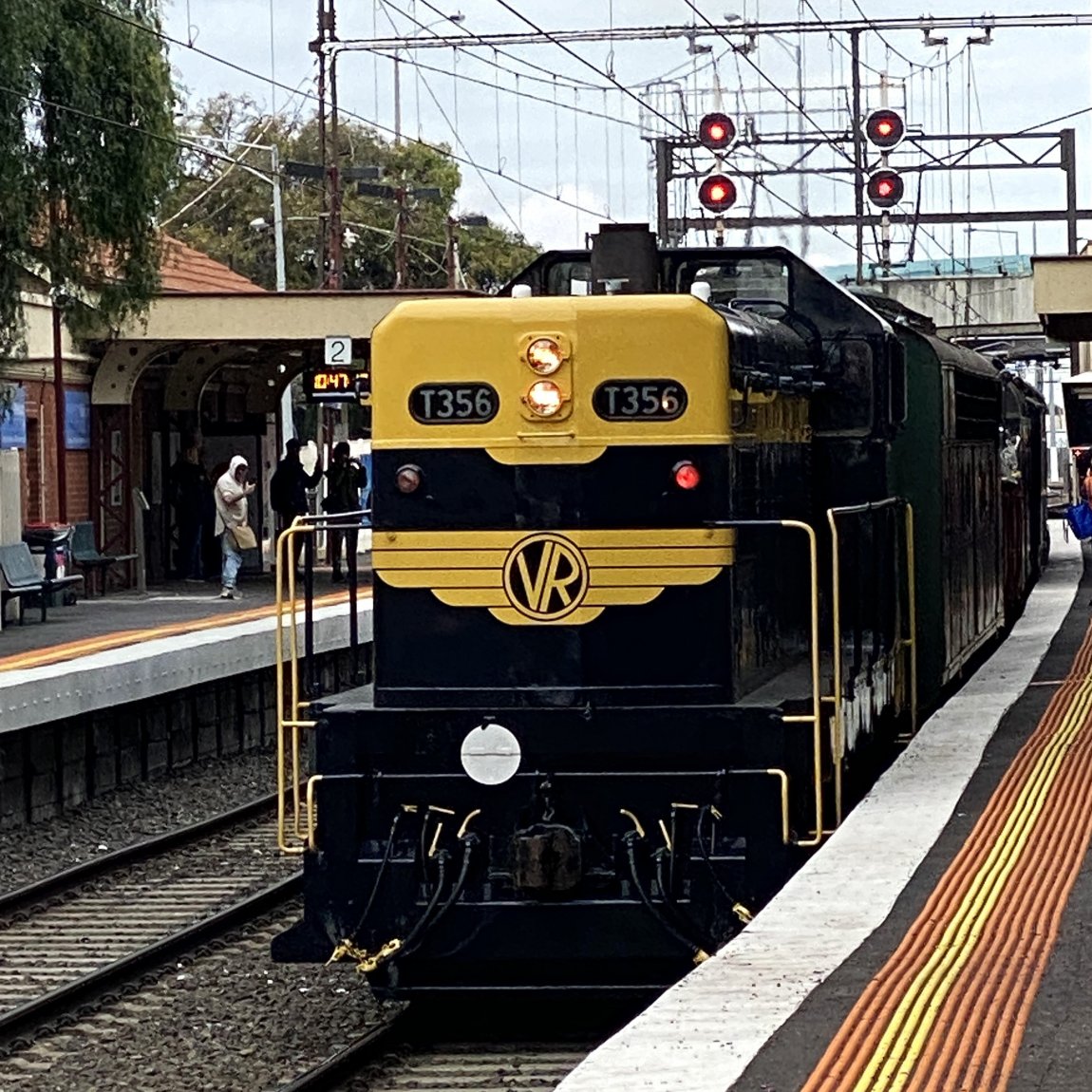
A Little Bit of History…
Heritage Diesel T356 was now pulling alongside Platform 1. Directly behind T356 was the heritage diesel S301, ’Sir Thomas Mitchell’, painted in the green livery of Pacific National. Behind S301 came a number of Sleeping and Crew cars, followed by five red-painted 2nd Class carriages, and one 1st Class carriage. We were informed that these are heritage E and W type carriages, dating back to 1908.
S301 belongs to the class of diesel locomotives built for the Victorian Railways between 1957 and 1961 by Granville (NSW) based Clyde Engineering. Of this class, S300 (Matthew Flinders) and S315 (Sir Charles Gavan Duffy) were part of the Royal Train for Prince Charles and Princess Diana, when they visited Ballarat in April 1983. Today, S300 is apparently under restoration at the Canberra Railway Museum, while S315 was scrapped in 1992.
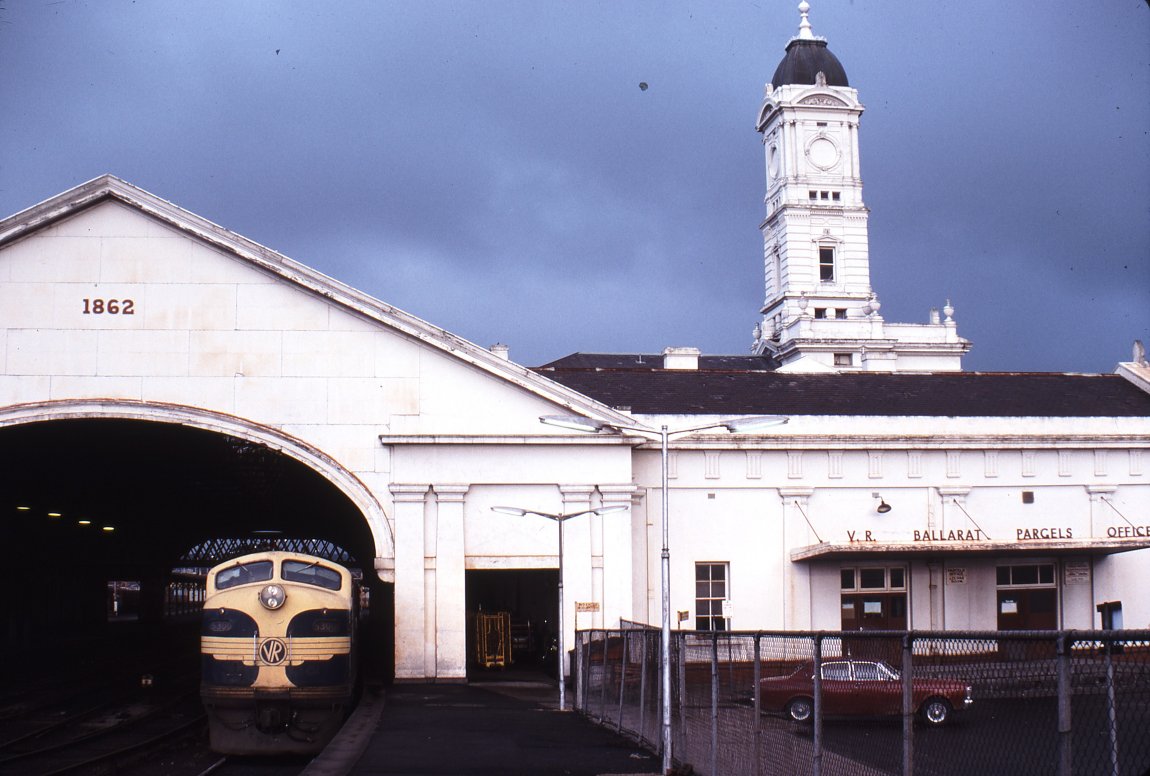
Ballarat Down Goods S 300 S 307 – Date Taken 22 August 1981 – Note the vacant space for the clock at the top of the Ballarat Station Clock Tower
At the other end of the line of carriages from the two heritage diesels, were steam locomotives, A2 986 and K153, with a Water Tank Wagon, VZVF1 coupled between the passenger carriages and K153. Once the entire train was stationary at Platform 1, the Steamrail Team were soon unlocking the carriages and inviting the anxiously waiting passengers to climb aboard.
The positioning of the different locomotives was explained in the Steamrail Victoria flyer: The diesels were “assisting” from the rear, while steam locomotives K153 and A2 986 were “hauling” the train from the front, with A2 986 as the leading engine.
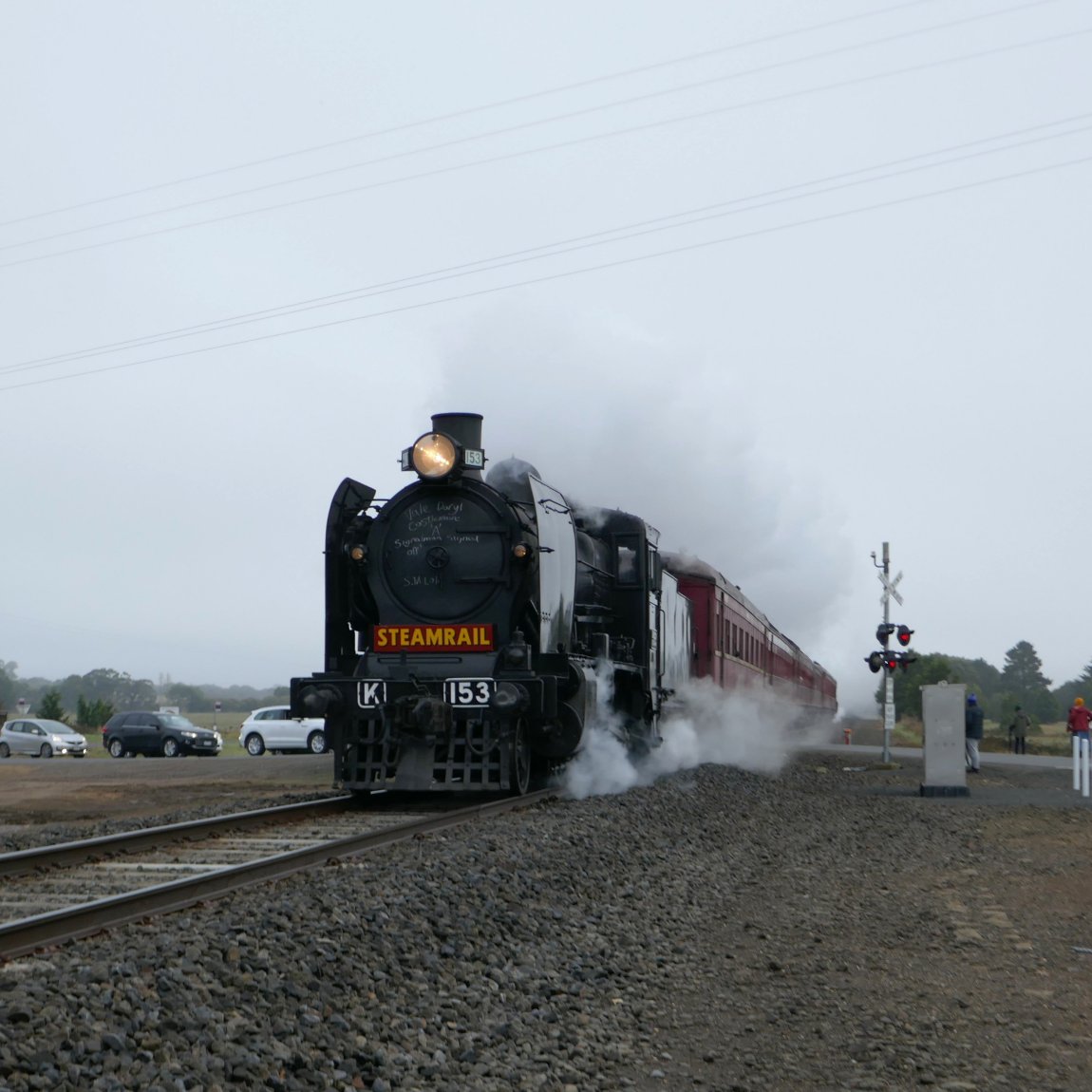
K Class steam locomotives were built at the Newport Workshops, and were run by Victorian Railways from 1922 to 1979. Originally designed for freight/goods work, K Class locomotives were considered to be highly versatile and dependable, and were also used for branchline passenger services. K Class locomotive K153 entered service in 1940, and is capable of reaching 80 kmh (which is the speed limit between Geelong and Ballarat).
A2 Class locomotives were designed and built by Victorian Railways, and were in service from 1907 to 1963. Following WW2, many A2 locomotives, including A2 986, were converted from coal to oil-firing. A2 986 was the last A2 in service, being withdrawn in December 1963. In 2015, A2 986 was restored to being a coal burner, before entering service with Steamrail in May 2017.
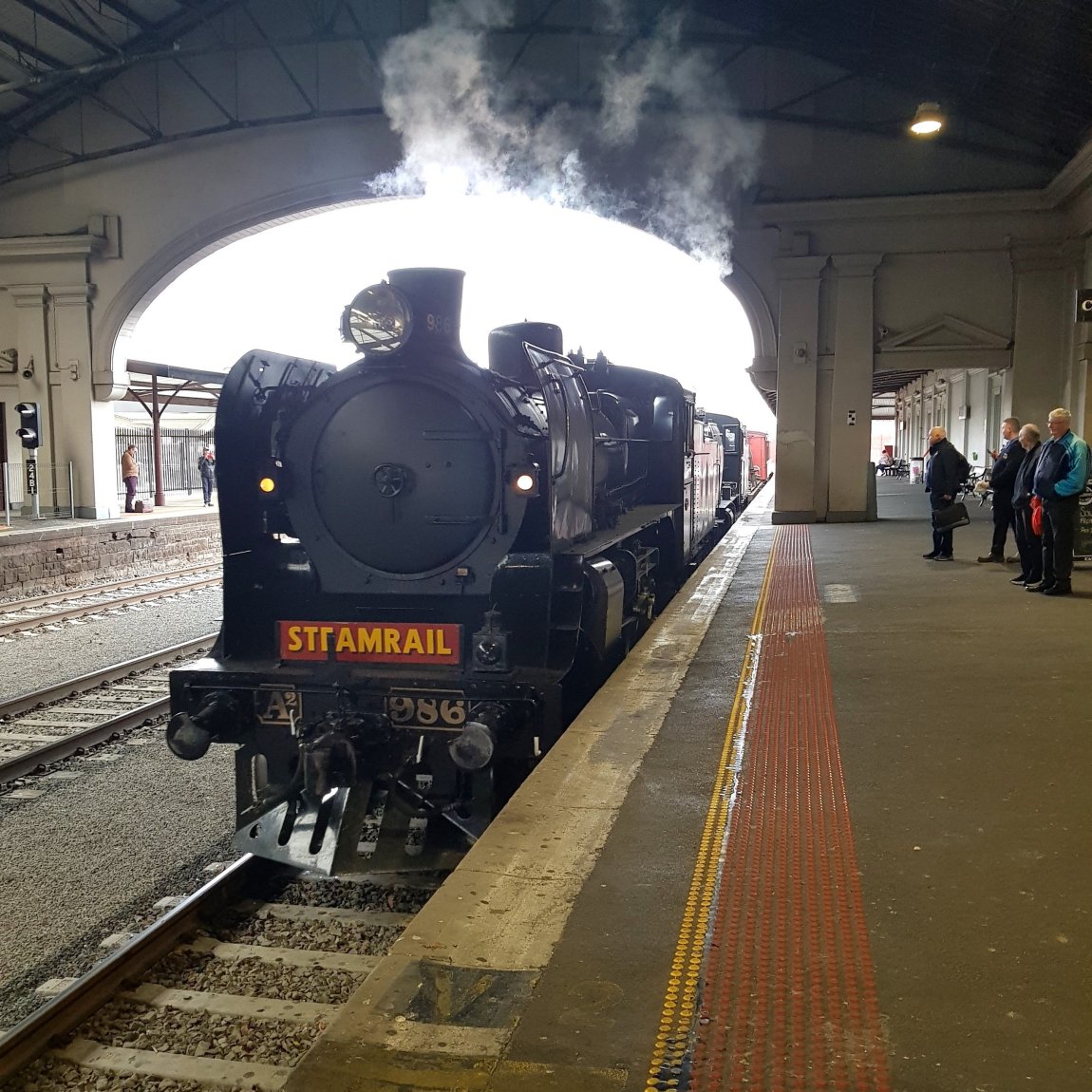
Going Back in Time…
As I boarded Carriage #1, I realised that I was now in a different world. Indeed, this was one that my great-grandparents, and even their parents, would have found familiar. I even found myself looking around to see if I could spot someone like Hercule Poirot, or maybe Miss Phryne Fisher. Unfortunately, they had not made the journey with us, today (maybe, some other time?).
I quickly settled into my timber panelled compartment, with eight rather ‘cosy’ seats, arranged in two banks of four, across the carriage. And, very soon, with a great ‘toot toot’, we were on our way, only 3 minutes late (thanks to Metro!). The Steamrail flyer timetable tells me what to expect, and when. After studying it again, I settle back to look out of the window, as we race along through suburban Melbourne, headed for Geelong.
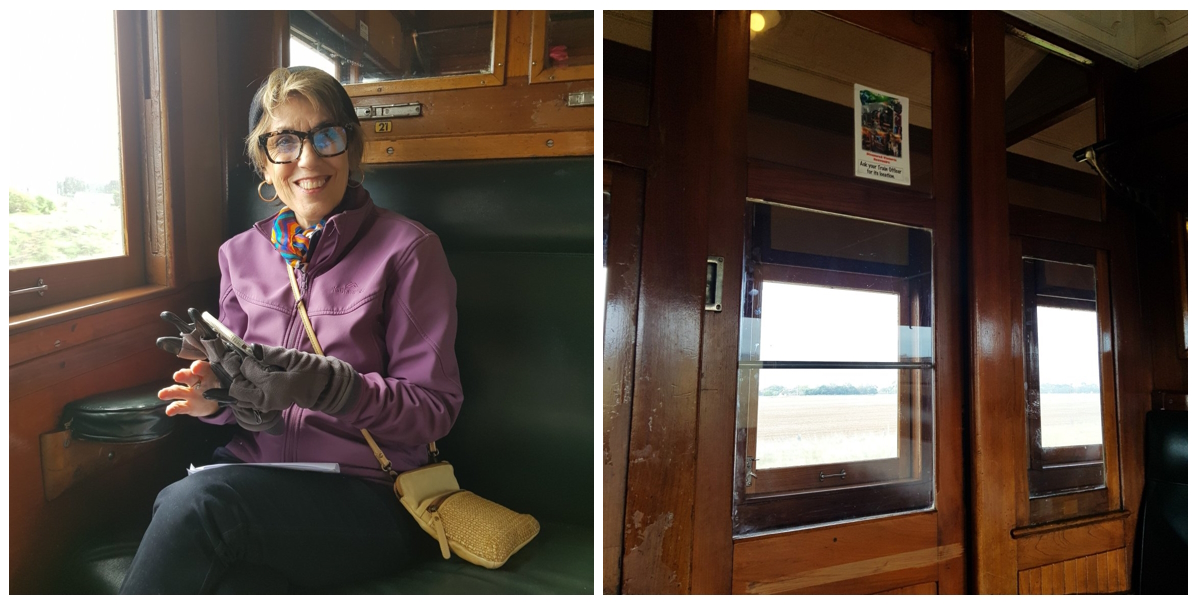
Laverton goes past, then Werribee. About then, a Steamrail Train Officer appears at the compartment door to confirm our tickets, and to have a bit of a ‘chat’. I learn about Steamrail volunteers, and about how he has ‘coal in his blood’ from several generations of railways people in his family.

Now is the time to go and do a bit of exploring, looking into the different compartments and checking out the washrooms. Up front there is a 1st Class carriage (I am in one of the five 2nd Class carriages today). Let me now show you one of the curiosities I came across:
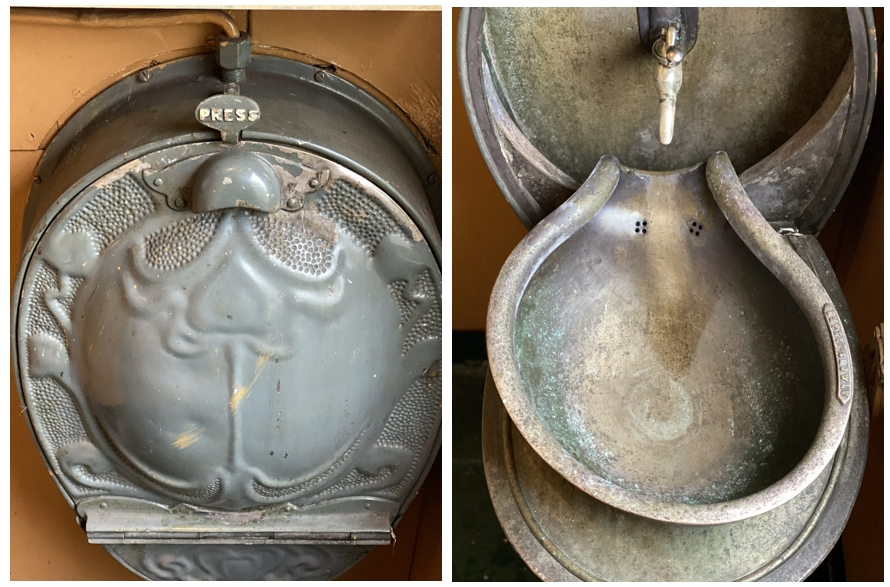
Running Ahead of Schedule…
We are now heading for Manor Junction, where a stop of around 10 minutes is scheduled, apparently while we wait to join the Geelong Line. However, after about two minutes, we start moving again, so we are running ahead of time by about 5 minutes. After we pass through Little River, the scene of a head-on train crash in 1884, outside my window, on the right, I can see the hills of the You Yangs.
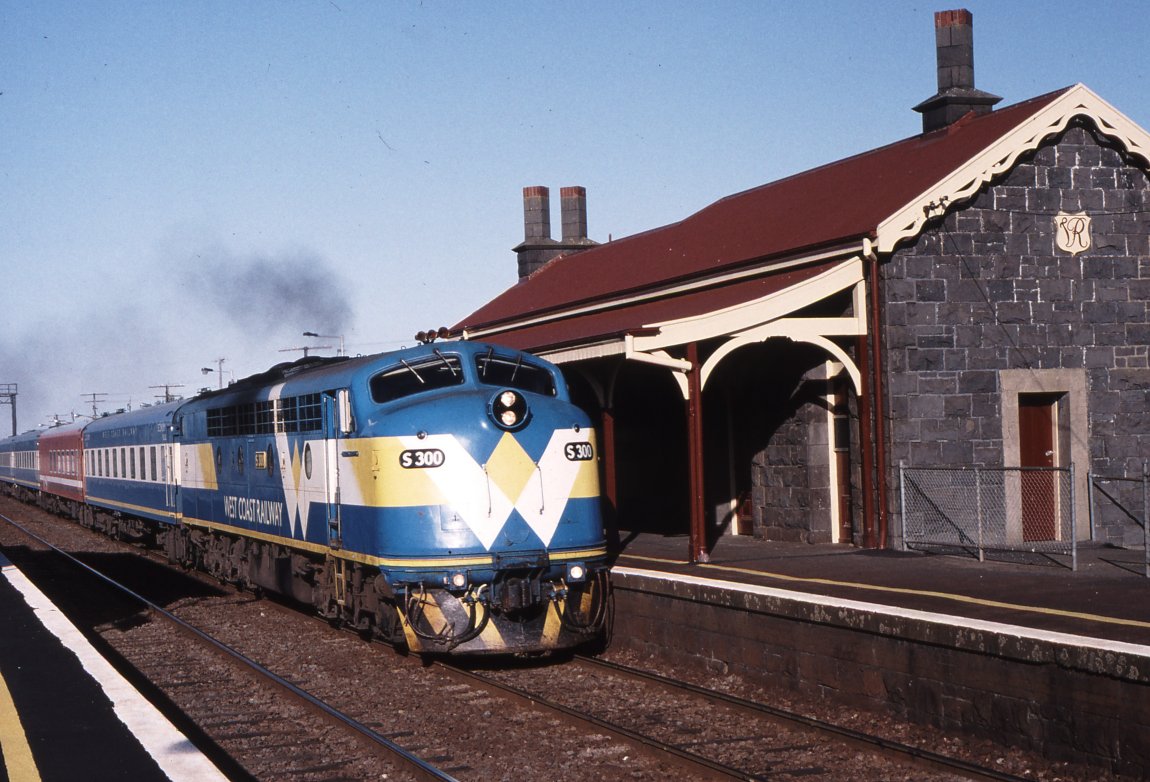
Little River 8237 Down Warrnambool Passenger S 300 – Date Taken 3 February 1998
Next on the timetable is Lara, where we are scheduled to take a 40-minute water stop. However, there is no stop, as we press on towards Geelong. Soon, we are slowing as we near Geelong, and its suburbia. As we round the tight-ish bend in the tracks at North Geelong, we have the opportunity for photographs of the front of the train (but nothing is supposed to hang outside the open window, people!).


Credit: OpenStreetMap
Once around the bend, we set off to the northwest, towards the Golden Plains. And, before long we are leaving suburbia behind, with green paddocks spreading out on our left. After a couple of road crossings, a change of sound from the wheels tells me we are onto the famous Moorabool Viaduct. However, there’s not much opportunity to really see anything here, apart from being able to discern that we are well above the ground below.
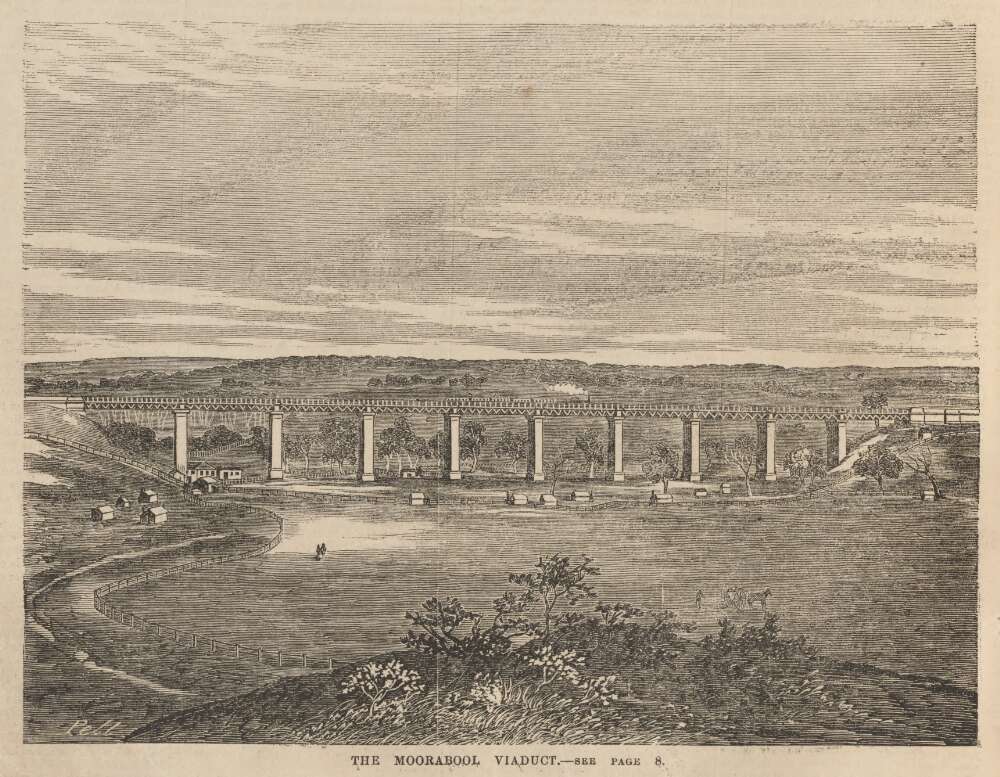
[nla.obj-140426538 – Out of Copyright]

[items/787256 – Licensed as Public Domain Mark]

Moorabool Viaduct km 79 8190 Uo Special Passenger Y 112 – Date Taken 2 November 1996
No More Small Stations…
By now, I am curiously concerned about the water stop. Will we run out of steam, just like the first official Ballarat to Geelong train did, in 1862? After finding our Train Officer, I am informed that the spot at Lara was needed by a V/Line freight train. However, there is water ahead, at Gheringhap.
And sure enough, soon we are stopping, seemingly in the middle of nowhere?! Obviously, there was once a station here. Now it is just several sets of tracks that I can see. As I mull over what to do for the next 30-40 minutes, we soon start moving again. That wasn’t much more than 10 minutes, maybe even less?
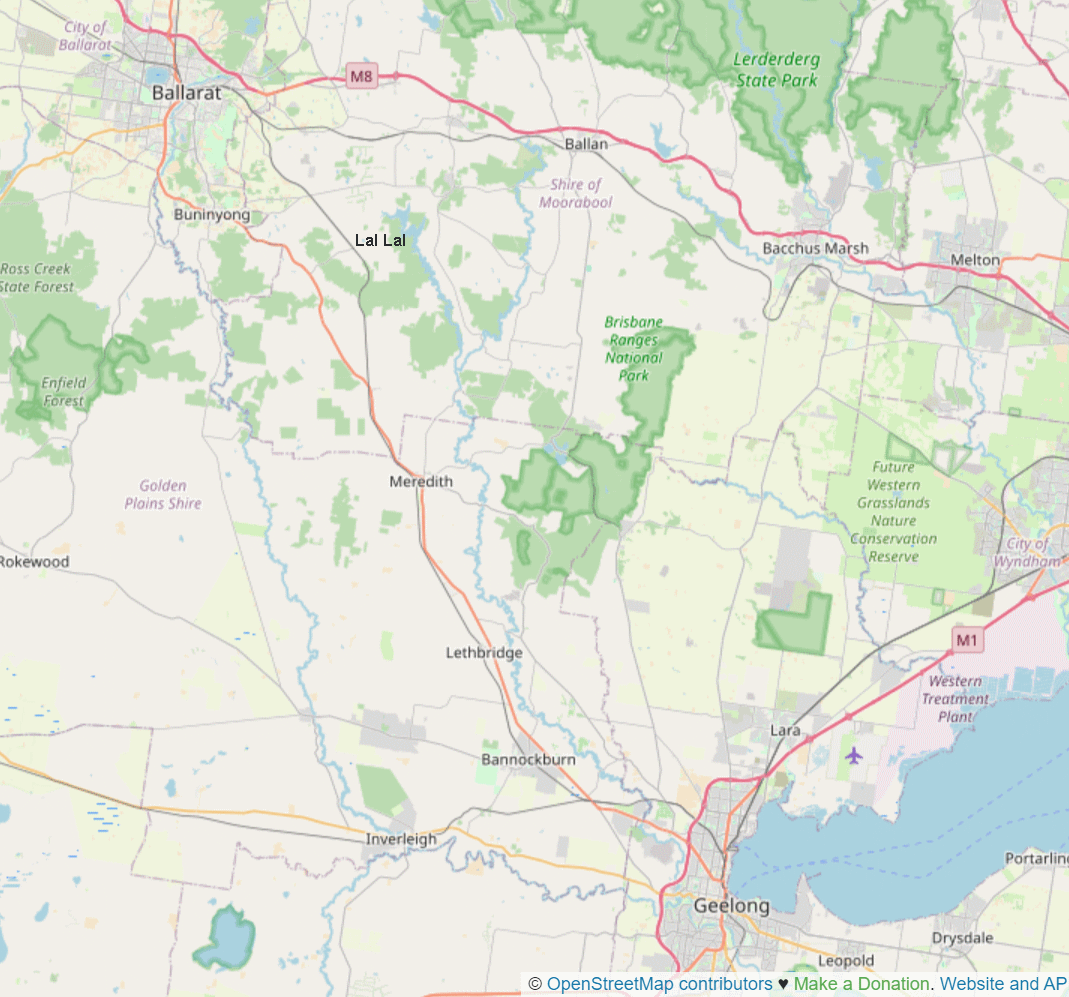
Credit: OpenStreetMap
Next on the timetable is Lethbridge. As we dash past, I catch a glimpse of bluestone buildings, all fenced off and boarded up. Supposedly, there is some plan to re-purpose this historic 1862 Station Building? As I look again at the timetable, it seems that we are running almost 30 minutes ahead of schedule.

Lal Lal – Date Taken 12 May 1973
We should be reaching Lal Lal at around 2:20 pm. Outside, we are still passing through fields and paddocks, while over to the right I can see vehicles traveling on the A300 Midland Highway. Unlike the V/Line trains, which seems to canter along at +110 kmh, these vehicles are leaving us behind. That said, we are still bowling along pretty well across the Golden Plains.

Meredith 8191 Down Special Passenger Y 112 – Date Taken 20 May 1996
Soon we run through Meredith, the scene of a wood-cutting expedition for the first official train on the Ballart to Geelong line. The tracks are now flanked by sections of trees and bush, rather than the earlier paddocks and fields. At Elaine, we cross the Midland Highway, so it is now on our left. Soon, we are into a section of bush, with the trees close to the track.
Well Ahead at Lal Lal…
As we climb up the incline towards Lal Lal, looking out, I spot a white Ford Ranger being loaded with cut pieces of firewood. Out of the bush and trees, and suddenly we are at Lal Lal. Again, I catch just a glimpse of what appears to be another historic, but deserted, old Station building.

Lal Lal 8193 Down ARE Special Y 112 – Date Taken 20 July 1996
Apparently, both Lal Lal and Lethbridge Stations required removal of asbestos before they could get ‘a new life’. Perhaps that’s the hold-up? We are now heading for Warrenheip, where the tracks will join with the Ballarat to Melbourne line.
The timetable says we should reach Warrenheip at 14:34 pm (that’s precise!), but my mobile tells me we are almost 40 minutes ahead of schedule. Maybe the two diesels down the back have been doing a bit of ‘pushing’? As we head towards our destination, we are running through sections with trees close to the tracks, and in other parts we look out over paddocks.

Credit: OpenStreetMap
As we climb towards the historic bluestone bridge at Navigators, our speed drops noticeably. Making our way slowly up the incline approaching Warrenheip, I look out of the window as the single line of track becomes double tracks. Curiously, all of the sleepers I can see on the other track are wooden, and some are quite new. Off to the side are several piles of old, well worn, and quite deteriorated sleepers. For all that, the ride is still quite smooth.
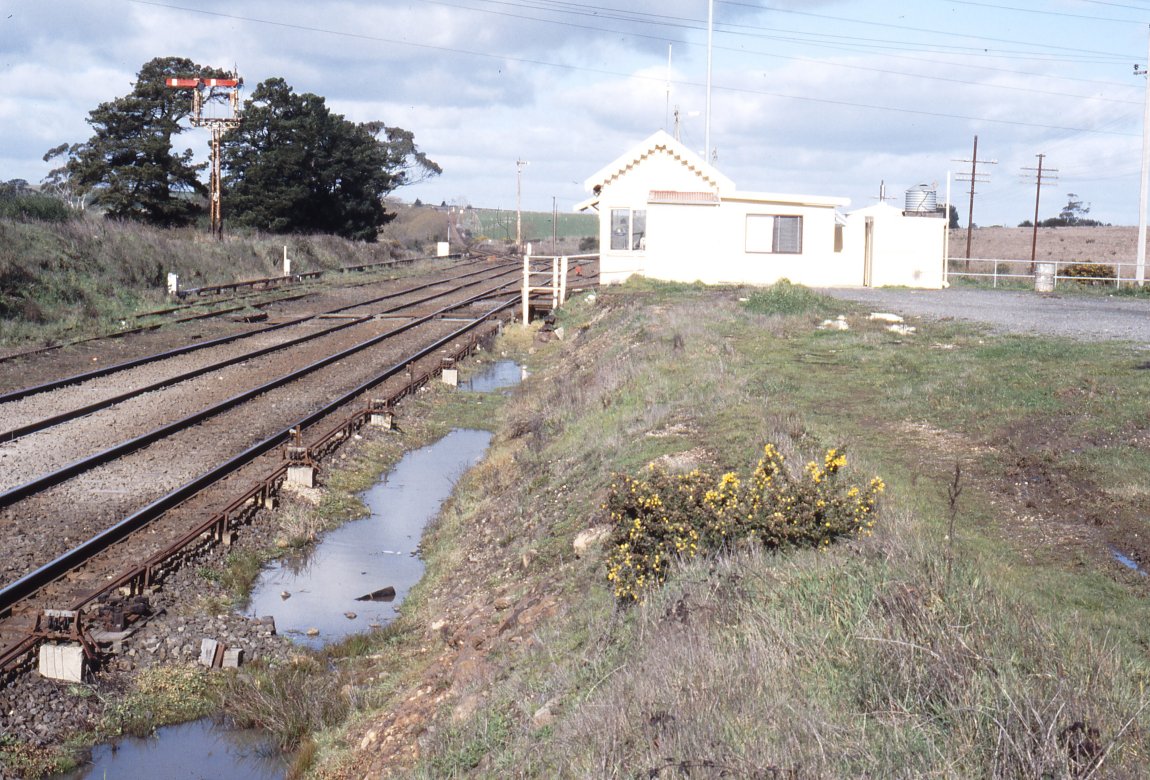
Warrenheip Looking towards Melbourne and Geelong – Date Taken 26 August 1990
Note: the track junction is just beyond the building
And Downhill to Ballarat…
Finally, we reach Warrenheip, where the tracks join, at 1:56 pm, not at 2:34. There is nothing at all to see here, the old Station Buildings are long gone. All that is left are the stories, like the one about the runaway train, that separated from the engine and rolled back towards Ballarat, in 1885.
And, just like the runaway, for us on the Ballarat Transfer, it is now all downhill. We roll down the bushy slope towards Brown Hill, where locals are out with their tripod cameras, and mobile phones. Then we cross over the Caledonia Bridge, the scene of the first problem for that first official train, back in 1862.

Ballarat East Down Goods A2 986 – Date Taken 18 December 1961
Now we straighten up and head into Ballarat, with yet more camera people out in various vantage positions. With a little over 1 Km of our journey left, we pass by the bluestone sheds that stand where the Ballarat East Station once was. As we do, we pass the bodies of several old steam locomotives, and some rolling stock.
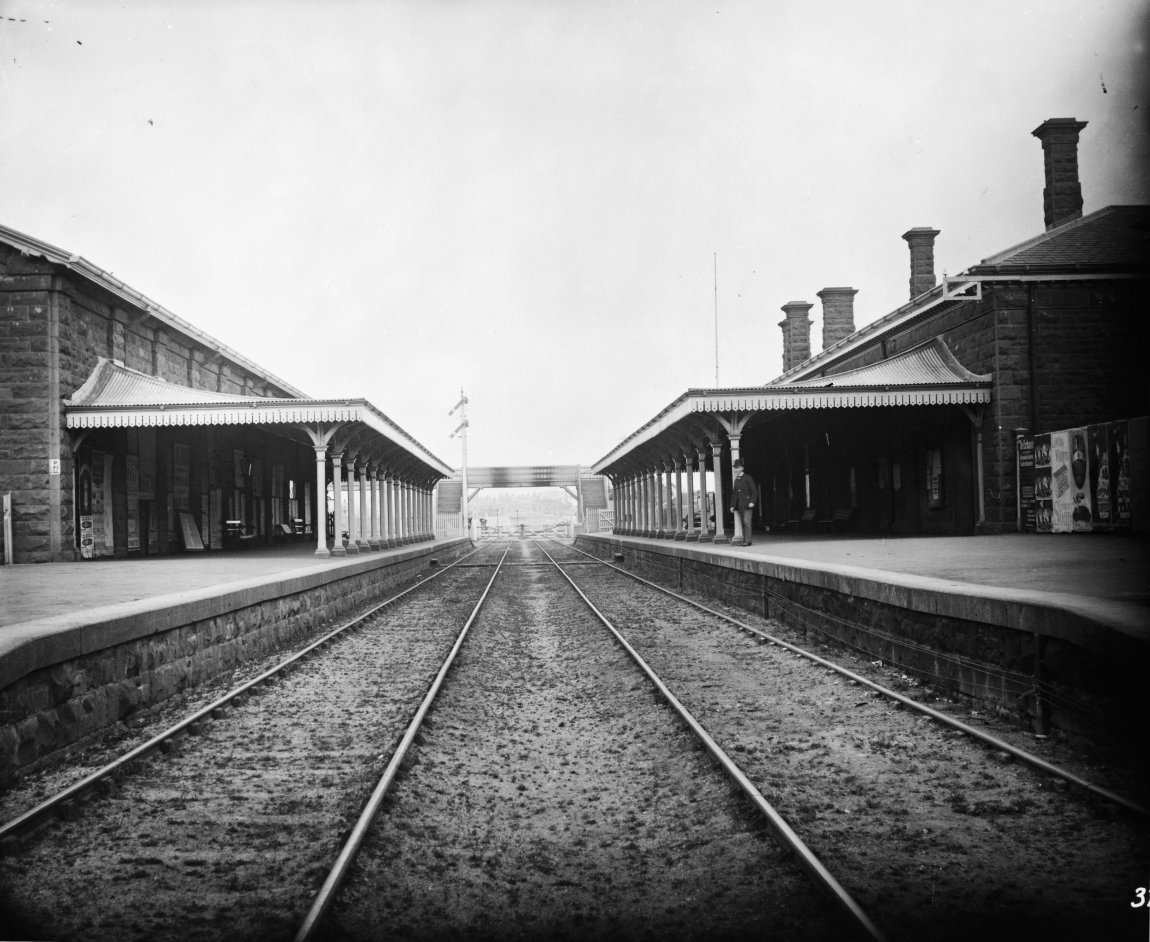
Ballarat East Railway Station was closed in the 1960’s and the station building was demolished
As we rumble into the yards of the Ballarat Railway Station, even the Railway workers are busy with their mobile phones, recording this special scene. Thinking about it, we are the first Steam Train of the 2024 season to arrive in Ballarat. And for the next two days, the once-familiar sound of the Steam Train would again be frequently ringing out across the Golden City.
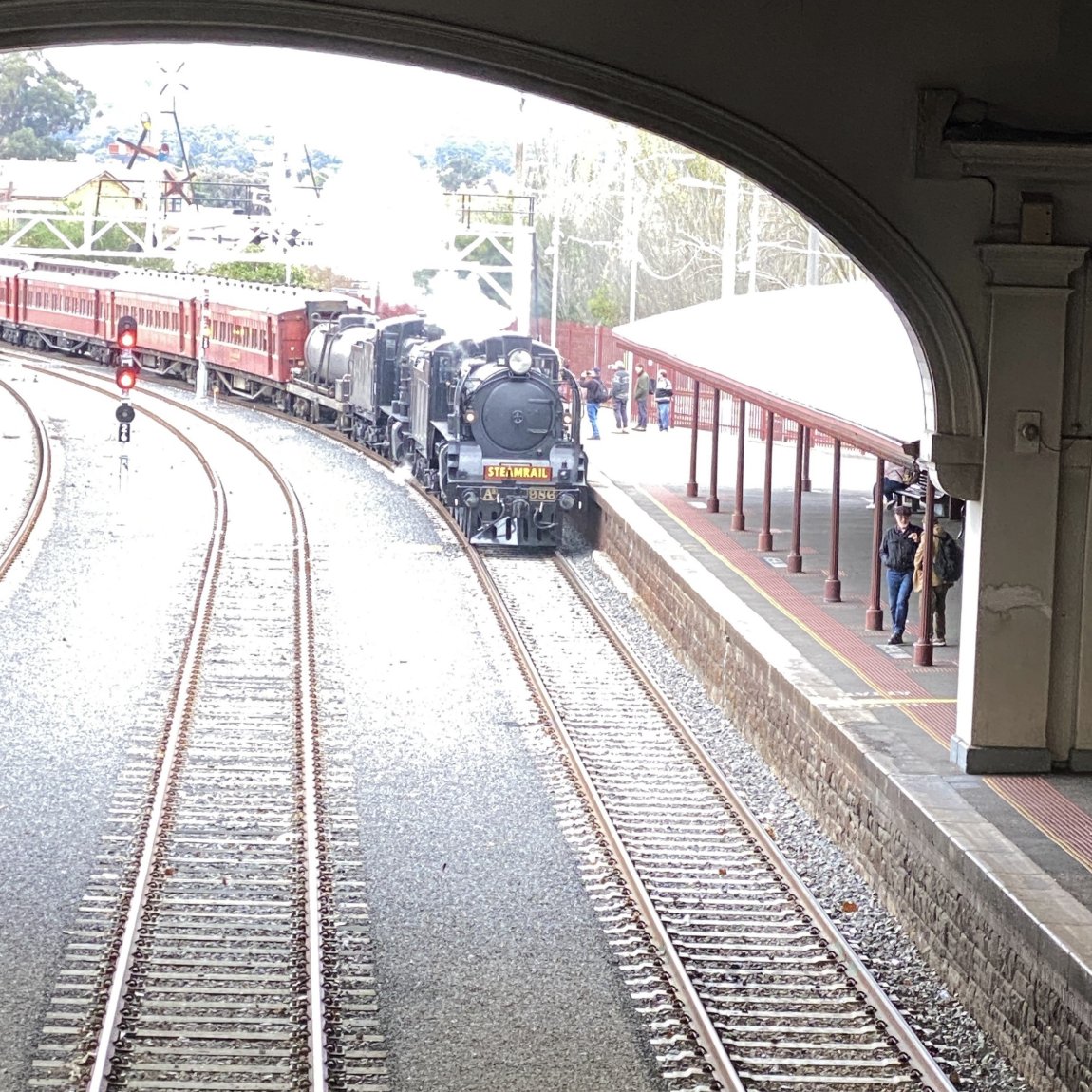
Into the Great Train Hall…
Our ETA at Ballarat was scheduled for 2:48pm, however we are into the Great Train Hall of the Ballarat Station at 2:09 pm. The Golden Plains Adventure is almost over. Now for some photographs of our train at Ballarat. And then, maybe a stop at the Station Refreshment Rooms (I do hope they are well prepared for all the hungry Steamrail travelers!).
One final thought about the journey today: How often can I recall travelling on a train in Victoria and arriving ahead of schedule? Never! This is certainly a new experience for me, and very well organised, at that!
Now, let’s enjoy some of the close-ups taken after our arrival at the Ballarat Station.

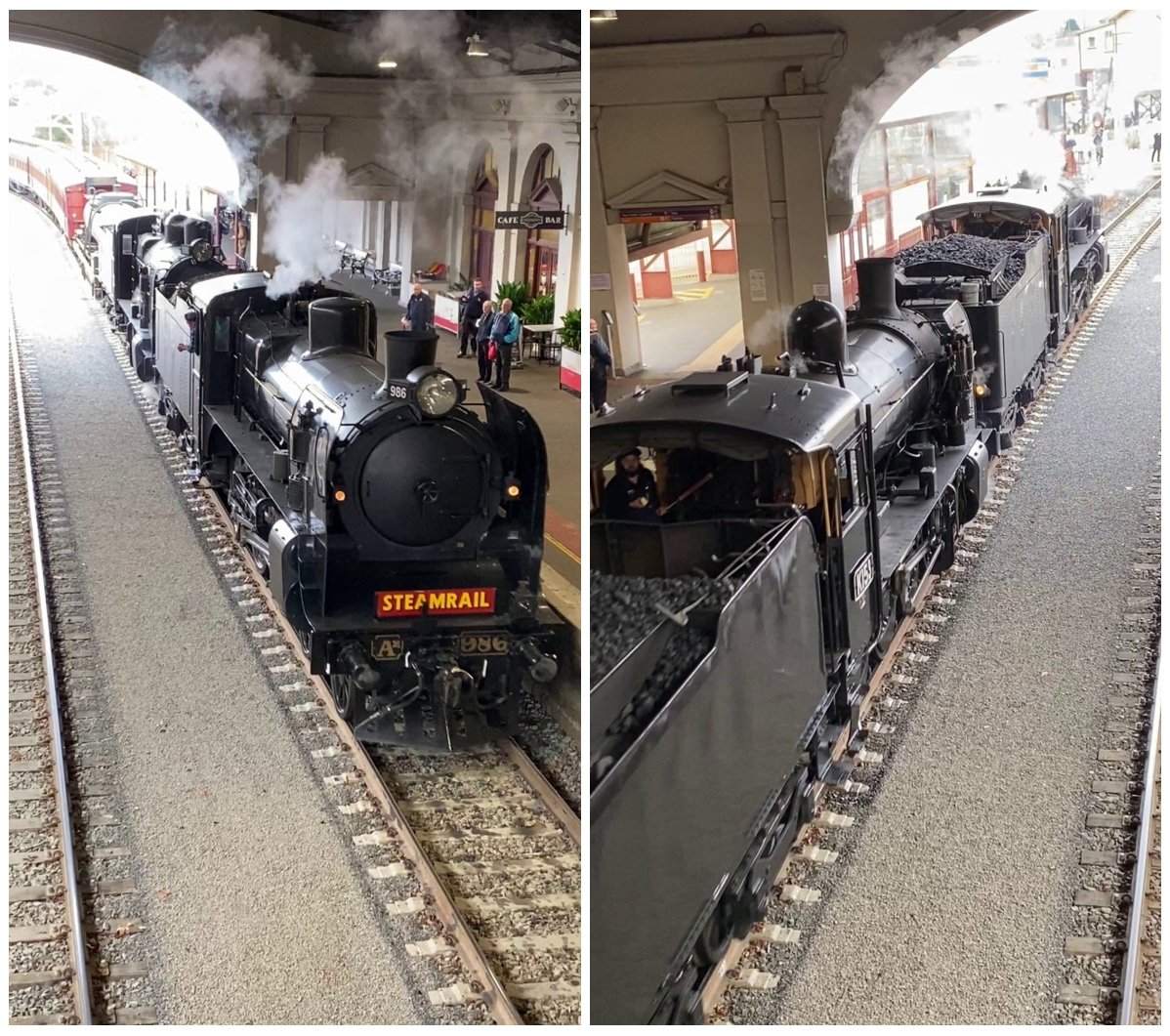


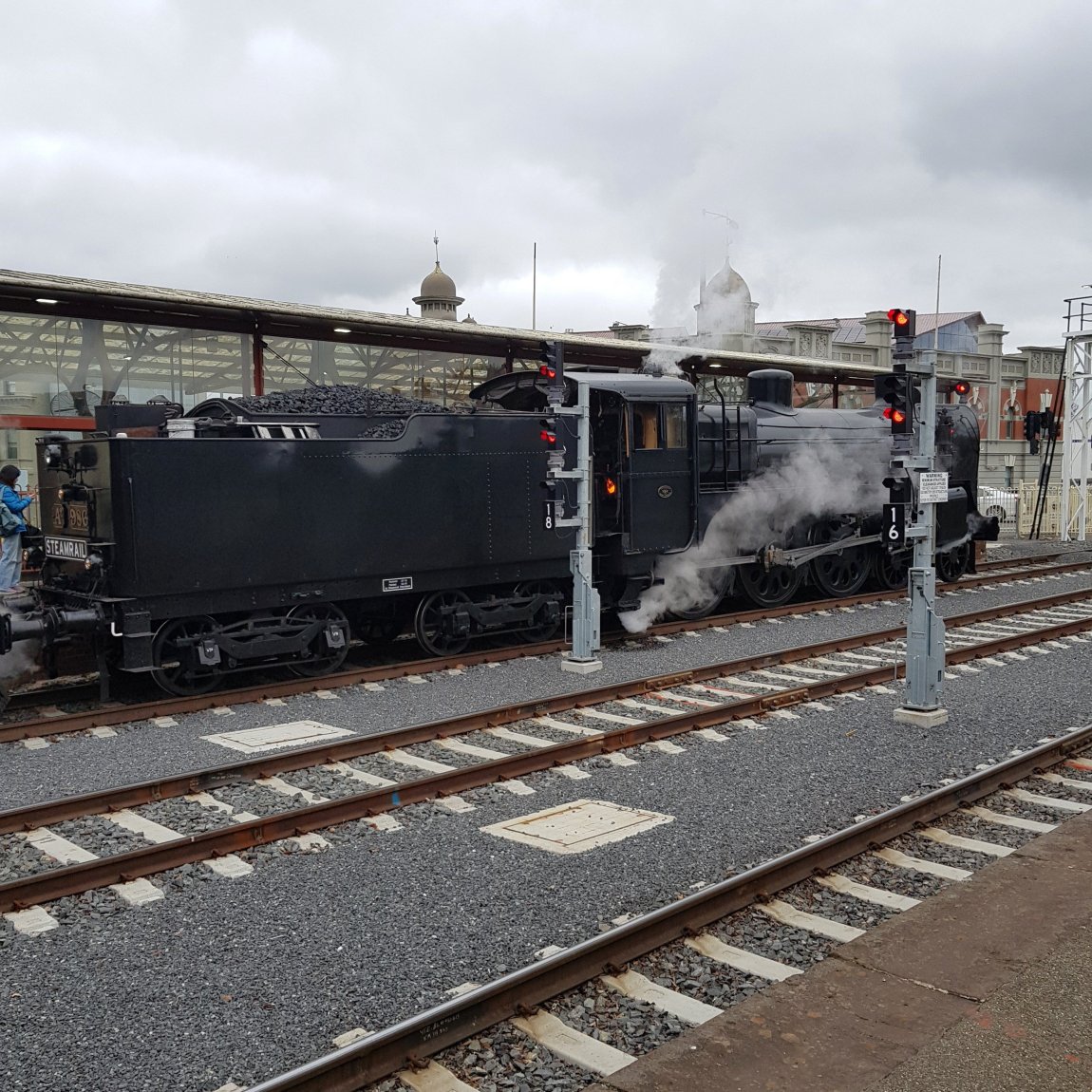
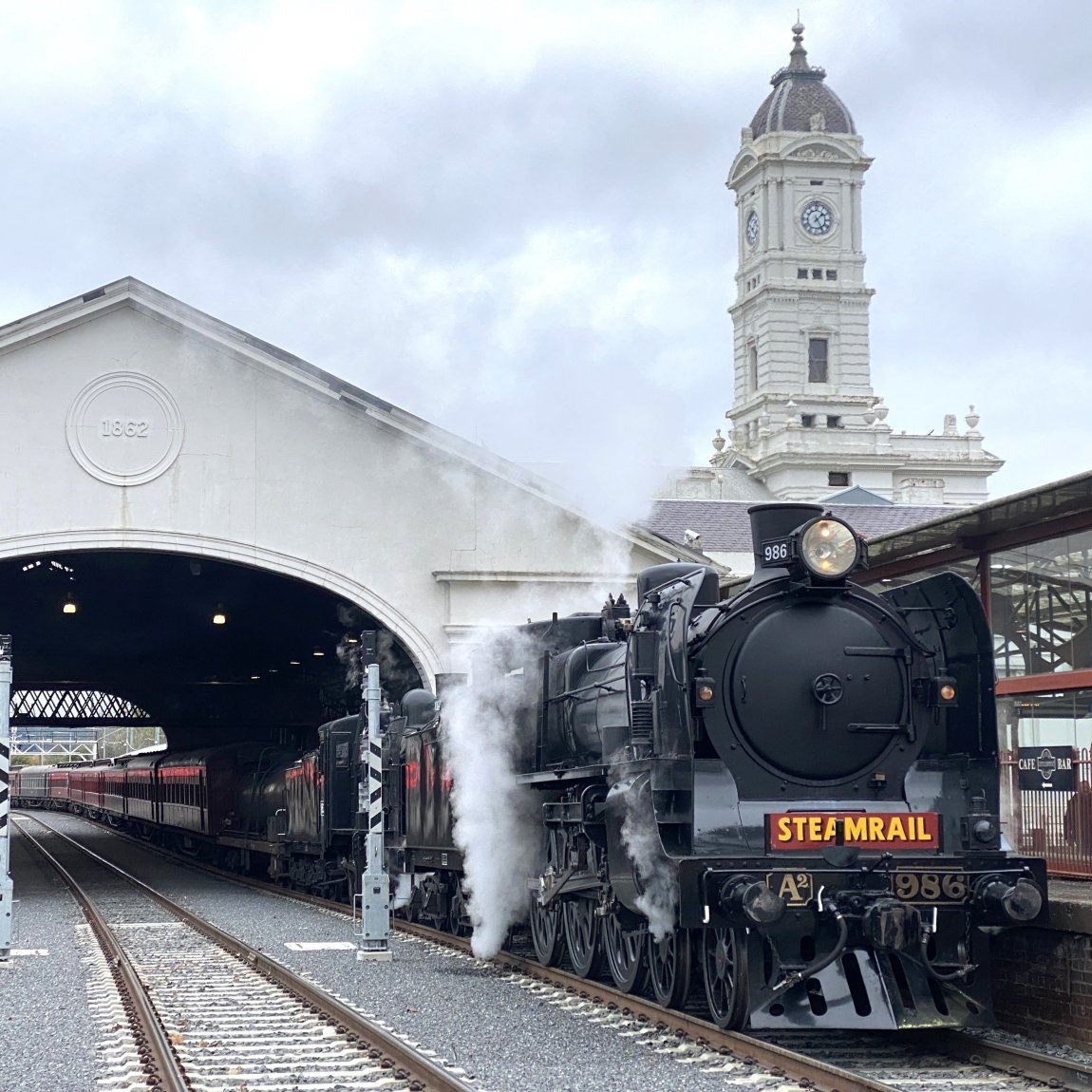
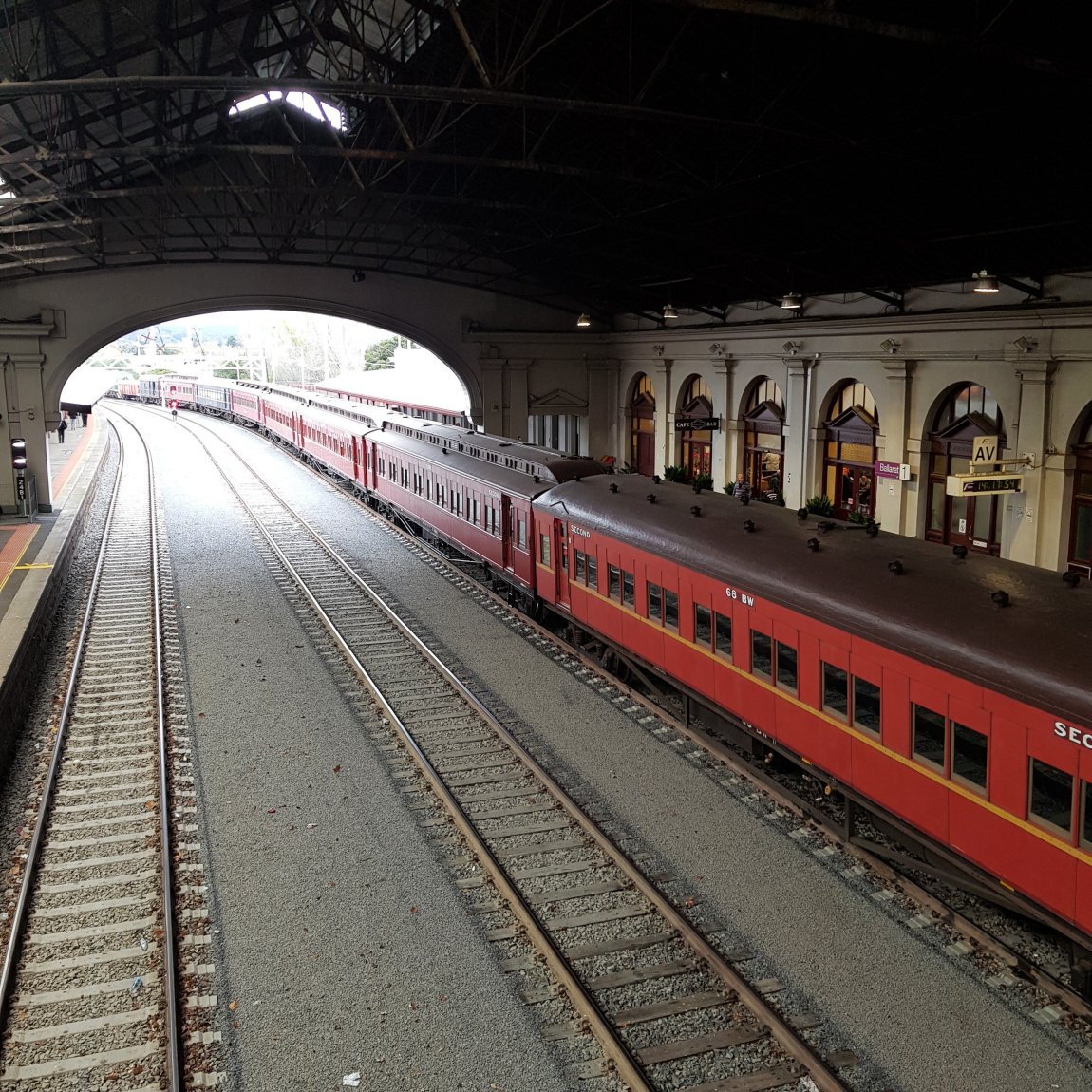
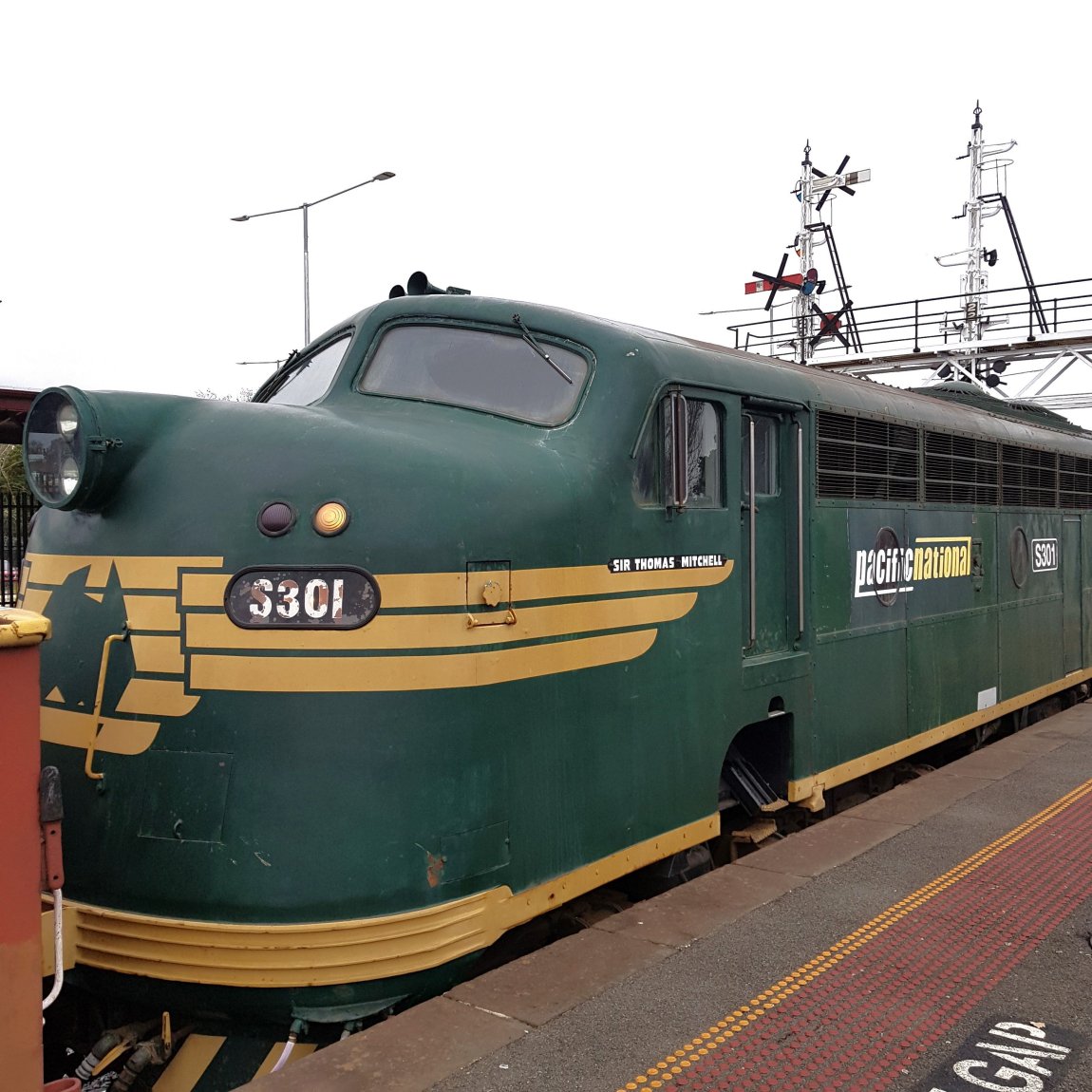

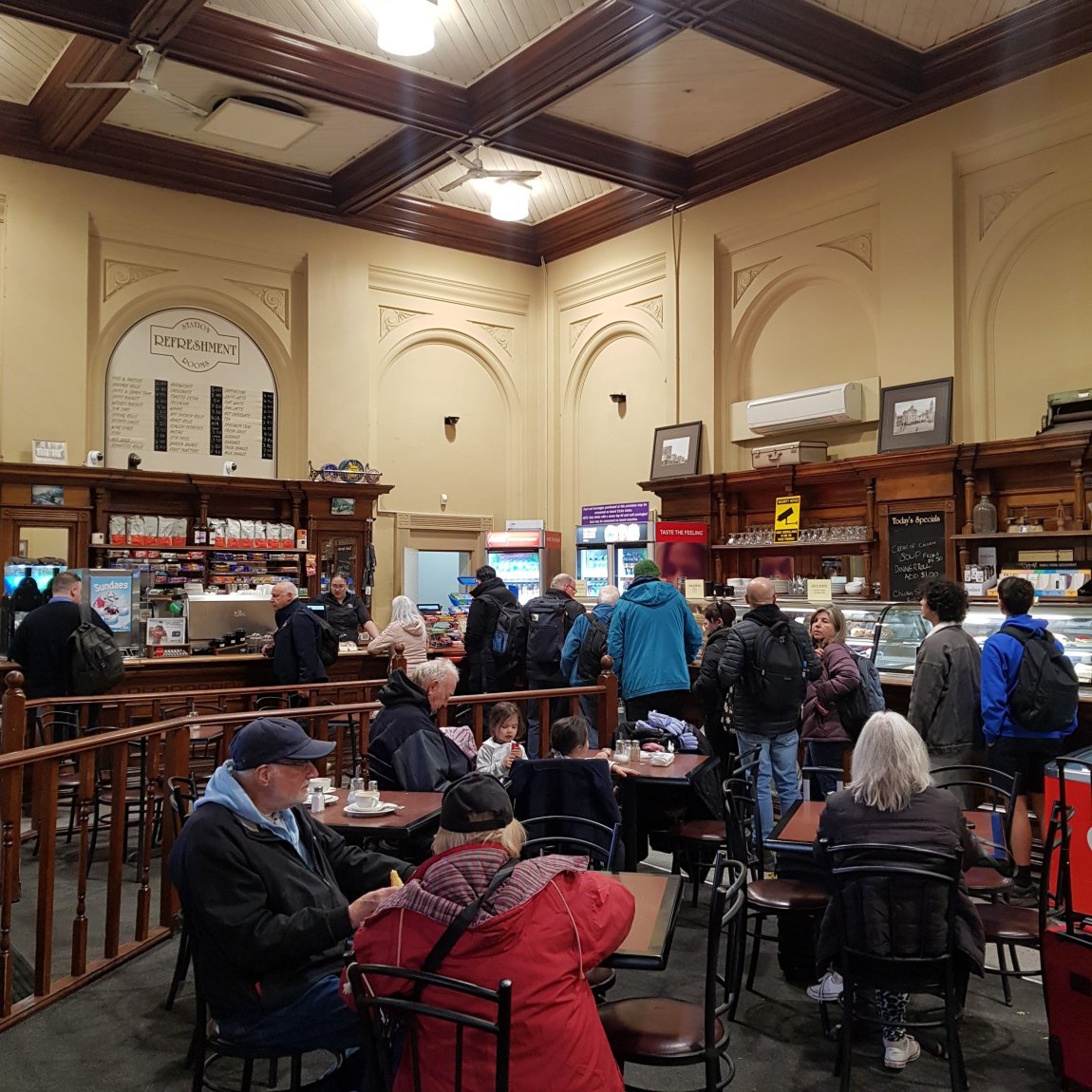


Top – K153 leading; Bottom – A2 986 trailing; Once at Lal Lal, the train reverses its direction, so A2 986 leads on the way back to Ballarat
Postscript Note:
Apparently our journey being ahead of schedule caught out a few photographers, as we steamed by while they were setting up, or were launching their drones. That’s a pity.
Useful Links
https://www.steamrail.com.au/about
https://www.westonlangford.com/
Your Guide to a 'Golden Plains Adventure', with Steamrail Victoria
Your Feedback, please…
Firstly, my thanks to you, for reading my post.
Now, the really BIG question is:
“What value has this Post offered you? “
Has it helped you, or do you need more information?
If you wish to offer some feedback, or to read the feedback from others, please follow the link below to the Feedback Page:
Why Your Feedback is Important to Me
In real life, I am an agile Change Manager, so I know that feedback is an essential part of the improvement process.
Your feedback can help me improve both the content of this Post, and also of future Posts.
If you have a thought, or a question, about the post content, or if you would like to provide feedback about something else, please follow the link to the Feedback Page.
I do look forward to hearing from you, especially if we can make improvements that will help fellow travelers on the road.
Marlene
Please note, before any feedback is posted, it will be moderated. When I am moderating, I may need to contact you, which is why I ask for your email address.
Your email address will
Here is a link to the my afootwego.com CONDITIONS for POST FEEDBACK (2½ mins to read).
Should you wish to peruse them, here are links to my afootwego.com PRIVACY POLICY and Website TERMS and CONDITIONS of USE.
- NOTE:
- This site is specifically designed for responsive display on a mobile device
On devices with wider screens, it will appear as a single, center-aligned column


